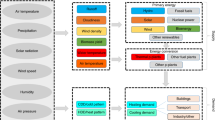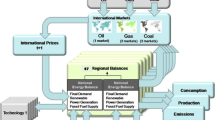Abstract
Much research is still needed to understand the climate vulnerability of the energy sector and to identify cost-effective adaptation options. This chapter explores the coupling of the World TIMES Integrated Assessment Model (TIAM-WORLD) with an emulated version of the climate model PLASIM-ENTS to assess the impacts of future temperature and precipitation changes on the heating and cooling subsector and available hydropower. An absence of climate feedback induced by the adaptation of the energy system to future heating and cooling needs was found for a 1.6–5.7 °C range of long-term global mean temperature increase: when aggregated at the global level, some changes compensate others, and heating and cooling represent a relatively small contributor to total energy consumption. However, significant changes are observed at the regional level in terms of additional power capacity, mostly coal power plants, to satisfy the additional cooling needs. Reduced needs for heating affect gas and coal heating systems more than biomass and electric heaters, reflecting higher costs of these heating options in the longer term. Available hydropower is estimated to increase on a seasonal basis in most regions under future climate change. It could therefore contribute to supply the additional electricity needed for cooling in regions where both future cooling needs and hydropower potential are expected to increase. Hydropower results are however characterized by high uncertainty due to uncertainties in projected precipitation changes as well as the relatively coarse resolution of PLASIM-ENTS.
Access this chapter
Tax calculation will be finalised at checkout
Purchases are for personal use only
Similar content being viewed by others
Notes
- 1.
Africa (AFR), Australia-New Zealand (AUS), Canada (CAN), United States (USA), Mexico (MEX), Central and South America (CSA), China (CHI), India (IND), Japan (JAP), South Korea (SKO), Other Develo** Asia (ODA), Middle East (MEA), Europe of 27 + Switzerland, Norway and Iceland (EUR), Other East Europe (OEE), Russia (RUS), Central Asia and Caucasia (CAC). OPEC and Non-OPEC disaggregation is considered within each region, when relevant.
References
Aebischer B, Henderson G, Jakob M, Catenazzi G (2007) Impact of climate change on thermal comfort, heating and cooling energy demand in Europe. ECEEE summer study, panel 5, energy efficient buildings, 859–870
Akpinar-Ferrand E, Singh A (2010) Modeling increased demand of energy for air conditioners and consequent CO2 emissions to minimize health risks due to climate change in India. Environ Sci Pol 13(8):702–712
Arent D, Tol R, Faust E, Hella J, Kumar S, Strzepek K, Tóth F, Yan D (2014) Key economic sectors and services. In: Field, CB., Barros VR, Dokken DJ, Mach KJ, Mastrandrea MD, Bilir TE, Chatterjee M, Ebi KL, Estrada YO, Genova RC, Girma B, Kissel ES, Levy AN, MacCracken S, Mastrandrea PR, White LL (eds) Climate change 2014: impacts, adaptation, and vulnerability. part A: global and sectoral aspects. Contribution of Working Group II to the Fifth Assessment Report of the Intergovernmental Panel on Climate Change. Cambridge University Press, Cambridge
Craig R (2011) Energy system impact. Technical report, FSU College of Law, Public Law Research Paper No. 503
Durmayaz N, Oguz Salim S (2006) Influence of cooling water temperature on the efficiency of a pressurized-water reactor nuclear-power plant. Int J Energy Res 30(10):799–810
Ebinger J, Vergara W (2011) Climate impacts on energy systems—key issues for energy sector adaptation. The international bank for reconstruction and development the World Bank, Washington, D.C
Fischer G, Nachtergaele F, Prieler S, van Velthuizen HT, Verelst L, Wiberg D (2008) Global agro-ecological zones assessment for agriculture (GAEZ 2008). IIASA, FAO, Laxenburg, Rome
Fraedrich K, Jansen H, Kirk E, Luksch U, Lunkeit F (2005) The planet simulator: towards a user friendly model. Meteorol Z 14(3):299–304
Haberl H, Erb K, Krausmann F, Bondeau A, Lauk C, Mller C, Plutzar C, Steinberger J (2011) Global bioenergy potentials from agricultural land in 2050: sensitivity to climate change, diets and yields. Biomass Bioenergy 35(12):4753–4769
Hamududu B, Killingtveit A (2012) Assessing climate change impacts on global hydropower. Energies 5:305–322
Holden PB, Edwards NR (2010) Dimensionally reduced emulation of an AOGCM for application to integrated assessment modelling. Geophys Res Lett 37:L21707, doi:10.1029/2010GL045137
Holden PB, Edwards NR, Garthwaite PH, Fraedrich K, Lunkeit F, Kirk E, Labriet M, Kanudia A, Babonneau F (2014) PLASIM-ENTSem: a spatiotemporal emulator of future climate for impacts assessment. Geosci Model Dev Discuss 6:3349–3380
IEA (2013a) Energy Statistics of Non-OECD countries. International Energy Agency, Paris
IEA (2013b) Energy statistics of OECD countries. International Energy Agency, Paris
IPCC (2011) IPCC Special Report on Renewable Energy Sources and Climate Change Mitigation. In: Edenhofer O, Pichs-Madruga R, Sokona Y, Seyboth K, Matschoss P, Kadner S, Zwickel T, Eickemeier P, Hansen G, Schlömer S, von Stechow C (eds) Prepared by working group III of the Intergovernmental Panel on Climate Change. Cambridge University Press, Cambridge, 1075 p
Isaac M, van Vuuren D (2009) Modeling global residential sector energy demand for heating and air conditioning in the context of climate change. Energy Pol 37(2):507–521
Labriet M., Joshi SR, Babonneau F, Edwards NR, Holden PB, Kanudia A, Loulou R, Vielle M (2013) Worldwide impacts of climate change on energy for heating and cooling. Mitigation and adaptation strategies for global change, online
Lehner B, Czisch G, Vassolo S (2005) The impact of global change on the hydropower potential of Europe: a model-based analysis. Energy Pol 33(7):839–855
Linnerud K, Mideksa T, Eskeland G (2011) The impact of climate change on nuclear power supply. Energy J 32:149–168
Loulou R (2008) ETSAP-TIAM: the TIMES integrated assessment model part II: mathematical formulation. CMS 5:7–40
Loulou R, Labriet M (2008) ETSAP-TIAM: the TIMES integrated assessment model part I: model structure. CMS 5:41–66
Lucena A, Salem Szklo A, Schaeffer R, Rodrigues de Souza R, Soares Moreira Cesar Borba B, Vaz Leal da Costa I, Olimpio Pereira A Júnior, Henrique Ferreira da Cunha S (2009) The vulnerability of renewable energy to climate change in Brazil. Energy Pol 37(3): 879–889
Mideksa T, Kallbekken S (2010) The impact of climate change on the electricity market: a review. Energy Pol 38(7):3579–3585
Mima S, Criqui P (2009) Assessment of the impacts under future climate change on the energy systems with the POLES model. In: International energy workshop 17–19 June, 2009. Fondazione Giorgio Cini, Italy
Moss RH, Edmonds JA, Hibbard KA, Manning MR, Rose SK, van Vuuren DP, Carter TR, Emore S, Kainuma M, Kram T, Meehl GA, Mitchell JFB, Nakicenovic N, Riahi K, Smith SJ, Stouffer RJ, Thompson AM, Weyant JP, Wilbanks TJ (2010) The next generation of scenarios for climate change research and assessment. Nature 463:747–756
Pokhrel Y, Oki T, Kanae S (2008) A grid based assessment of the global theoretical hydropower potential. Journal of Hydraulic Engineering 52:7–12
Rubbelke D, Vogele S (2011) Impacts of climate change on european critical infrastructures: the case of the power sector. Environ Sci Pol 14(1):53–63
Schaeffer R, Szklo A, de Lucena A, Borba B, Nogueira L, Fleming F, Troccoli A, Harrison M, Boulahya M (2012) Energy sector vulnerability to climate change: a review. Energy 38(1):1–12
Seljom P, Rosenberg E, Fidje A, Haugen JA, Meir M, Rekstad J, Thore J (2011) Modelling the effects of climate change on the energy system—a case study of Norway. Energy Pol 39(11):7310–7321
van Vliet MTH, Yearsley JR, Ludwig F, Vögele S, Lettenmaier DP, Kabat P (2012) Vulnerability of US and European electricity supply to climate change. Nature Climate Change 2:676–681
Wilbanks TJ, Romero Lankao P, Bao M, Berkhout F, Cairncross S, Ceron J-P, Kapshe M, Muir-Wood R, Zapata-Marti R (2007a) Industry, settlement and society. In: Parry ML, Canziani OF, Palutikof JP, van der Linden PJ, Hanson CE (eds) Climate change 2007: impacts, adaptation and vulnerability. Contribution of working group II to the fourth assessment report of the intergovernmental panel on climate change, pp 357–390. Cambridge University Press, Cambridge
Wilbanks TJ, Bhatt V, Bilello DE, Bull SR, Ekmann J, Horak WC, Huang YJ, Levine MD, Sale MJ, Schmalzer DK, Scott MJ (2007b) Effects of climate change on energy production and use in the United States. Department of Energy, Office of Biological and Environmental Research, Washington, DC, p 160
Williamson M, Lenton T, Shepherd J, Edwards NR (2006) An efficient numerical terrestrial scheme (ENTS) for earth system modelling. Ecol Model 198(34):362–374
Acknowledgments
The research leading to these results has received funding from the EU Seventh Framework Programme under Grant Agreement no. 265170 (Project ERMITAGE—Enhancing Robustness and Model Integration for The Assessment of Global Environmental Change).
Author information
Authors and Affiliations
Corresponding author
Editor information
Editors and Affiliations
Rights and permissions
Copyright information
© 2015 Springer International Publishing Switzerland
About this chapter
Cite this chapter
Labriet, M., Biberacher, M., Holden, P.B., Edwards, N.R., Kanudia, A., Loulou, R. (2015). Assessing Climate Impacts on the Energy Sector with TIAM-WORLD: Focus on Heating and Cooling and Hydropower Potential. In: Giannakidis, G., Labriet, M., Ó Gallachóir, B., Tosato, G. (eds) Informing Energy and Climate Policies Using Energy Systems Models. Lecture Notes in Energy, vol 30. Springer, Cham. https://doi.org/10.1007/978-3-319-16540-0_21
Download citation
DOI: https://doi.org/10.1007/978-3-319-16540-0_21
Published:
Publisher Name: Springer, Cham
Print ISBN: 978-3-319-16539-4
Online ISBN: 978-3-319-16540-0
eBook Packages: EnergyEnergy (R0)




